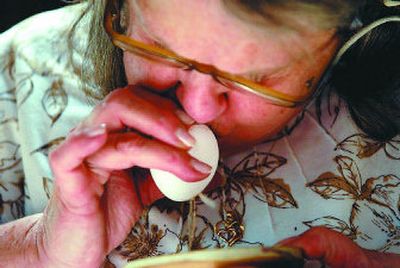Color your eggs with nature’s hues

Scientists tend to be a curious lot, and South Hill resident Eileen Starr is no exception. The retired earth scientist started experimenting with natural dyes a few years ago.
“I was curious about what color dyes different plant materials would make,” she said. “The cheapest way for me to experiment was to use eggs.”
A large wreath composed of colored eggs hangs in her kitchen. The tones are subtler and have richer hues than those found in eggs colored with commercial dyes. Starr said you can use fresh plant matter or dried leaves and flowers.
Onion skins make one of the easiest homemade dyes. The papery outer layers that collect in the bottom of our vegetable bins are inexpensive and readily available.
Starr covers a handful of yellow onion skins with water and boils for 20 minutes. Since she uses eggs for decorative purposes, Starr removes the egg from the shell by making tiny pinpricks at either end, and gently blowing the liquid contents out of the shell into a container. It’s important to wash the eggs well before doing this. For traditional Easter eggs, just hard-boil them as you normally would.
After 20 minutes she strains the onion skins with cheesecloth. “Pantyhose works just as well,” she said.
Starr pours the remaining liquid into an 8 oz. jelly jar, and drops an egg into it.
The amount of time the egg sits in the dye determines the color. Eggs left in the dye less than a minute are dyed a warm buttery hue. A five-minute bath creates a soft brown shade, and a 10-minute soak results in a deep coppery tone. Leaving the egg in the dye overnight will produce a brilliant burnt-orange color.
Any leftover dye can be frozen.
If you’re going to be eating the dyed eggs, be sure to refrigerate them when soaking longer than a few minutes.
To add shine and protect decorative dyed eggs, spritz them with an acrylic spray found at craft stores.
Starr said she’s amazed at the different colors these natural dyes produce. Red cabbage leaves make blue tones, yellow marigolds a startling green, and grass clippings create a yellowish-tan hue. Starr likes the fact that she can use what she has on hand to create these organic dyes.
“I’m often surprised at the colors,” she said. “It’s never what you expect.”